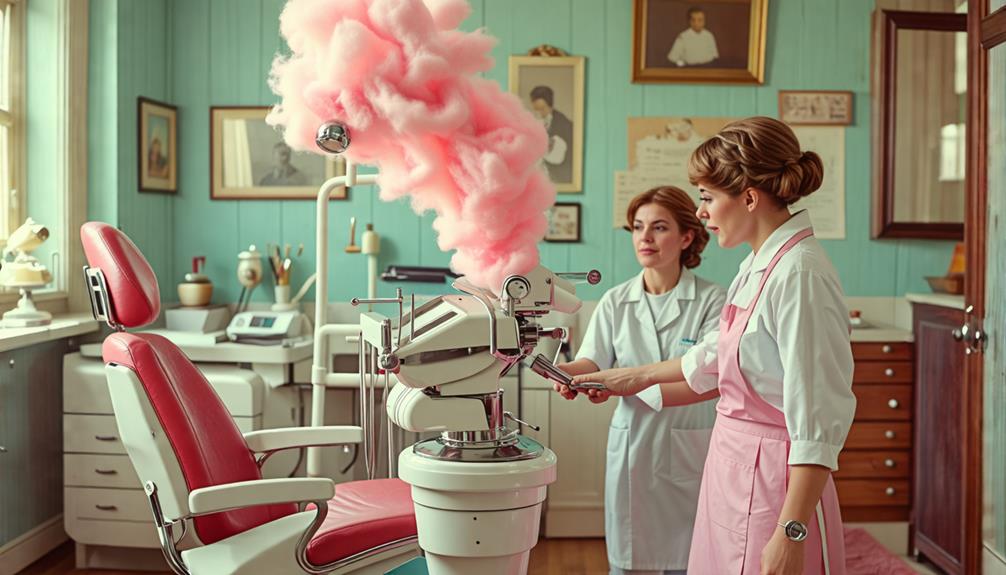You might find it ironic that a dentist played a key role in creating one of the most sugary treats at carnivals and fairs. Dr. William J. Morrison's collaboration with candy maker John C. Wharton led to the invention of the cotton candy machine in 1897. Their creation, initially called "Fairy Floss," transformed the way people enjoyed spun sugar. But what drove a dental professional to develop a confection that could potentially harm teeth? The story behind this unlikely partnership reveals an interesting blend of innovation, entrepreneurship, and the changing landscape of American sweets at the turn of the 20th century.
Key Takeaways
- Dr. William J. Morrison, a dentist, invented the electric cotton candy machine in 1897.
- Morrison partnered with candy maker John C. Wharton to develop the machine.
- The device melted sugar and spun it through a wire screen, creating the fluffy treat.
- Initially called "Fairy Floss," the invention debuted at the 1904 World's Fair in St. Louis.
The Dentist's Sweet Innovation

Dr. William J. Morrison, a dentist by trade, unexpectedly revolutionized the confectionery world in 1897 with his invention of the electric cotton candy machine. You might wonder why a dentist would create a sugar-laden treat, but Morrison's innovation transformed the way we enjoy spun sugar.
Partnering with candy maker John C. Wharton, he developed a device that melted sugar and forced it through a wire screen, creating delicate, airy strands. The result? A fluffy confection they dubbed 'Fairy Floss.'
This electric candy machine made its grand debut at the 1904 World's Fair in St. Louis, where it captivated fairgoers. Morrison and Wharton sold over 65,000 boxes of their cotton candy at 25 cents each, proving that sometimes the most unlikely inventors can create something truly sweet and enduring.
From Fairy Floss to Fame
The whimsical treat known as 'Fairy Floss' didn't just captivate fairgoers; it sparked a confectionery revolution that would transform the American carnival landscape.
At the 1904 St. Louis World's Fair, Morrison and Wharton's sugary innovation took center stage, selling an astounding 65,655 boxes at 25 cents each. The duo's success grossed over $17,000, equivalent to more than $410,000 today. You'd think a dentist's appointment book would be filled with cavity treatments after such a sugar-filled event!
As Fairy Floss's popularity soared, its name evolved to cotton candy, becoming a staple at fairs across the nation.
The treat's light texture and unique appearance secured its place in history among America's most impressive desserts. From its humble beginnings to its widespread fame, cotton candy has truly spun its way into the hearts of generations.
Global Impact of Cotton Candy

From fairgrounds to festivals across the globe, cotton candy has spun its way into the hearts of millions, leaving a trail of sweet memories and sticky fingers in its wake. The invention of the spinning machine by Morrison and Wharton transformed this sugary treat from a luxury to an accessible confection, fueling its global popularity.
You'll find cotton candy under various names worldwide, reflecting cultural variations. In Australia, it's still known as 'fairy floss,' while British and New Zealand folks call it 'candy floss.' Afrikaans speakers use the whimsical term 'spookasem,' meaning 'ghost breath,' and the French affectionately refer to it as 'dad's beard.'
This fluffy delight has become a staple at cultural events and celebrations, enchanting people of all ages. Its widespread accessibility has cemented cotton candy's place as a beloved treat in diverse cultures around the world.
Conclusion
You've learned how a dentist, of all people, helped create a sugary sensation. Who would've thought?
From its debut as 'Fairy Floss' to its global popularity today, cotton candy has spun its way into our hearts.
Next time you're enjoying this fluffy treat at a fair or carnival, remember Dr. Morrison's unexpected contribution.
It's a sweet reminder that innovation can come from the most surprising places.

Leave a Reply